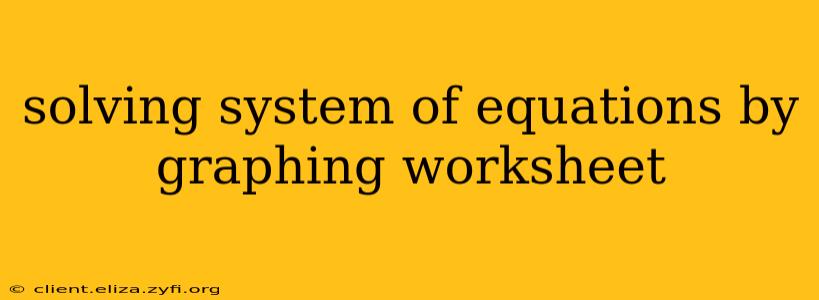Solving systems of equations is a fundamental concept in algebra, and graphing provides a visual and intuitive method to find solutions. This worksheet guide will walk you through the process, providing examples and tips to master this crucial skill. We'll cover various scenarios, including systems with one solution, no solution, and infinitely many solutions.
What is a System of Equations?
A system of equations is a set of two or more equations with the same variables. The goal is to find the values of the variables that satisfy all equations simultaneously. These values represent the point(s) of intersection on a graph.
Solving Systems of Equations by Graphing: Step-by-Step
Here's a step-by-step guide to solving systems of equations graphically:
-
Graph Each Equation: Rewrite each equation in slope-intercept form (y = mx + b), where 'm' is the slope and 'b' is the y-intercept. This makes graphing easier. If an equation isn't easily put into slope-intercept form, you can find two points that satisfy the equation and draw a line through them.
-
Identify the Point(s) of Intersection: Look for where the lines intersect on the graph. The coordinates (x, y) of this point represent the solution to the system. If the lines are parallel, there's no solution. If the lines coincide (they are the same line), there are infinitely many solutions.
-
Check Your Solution: Substitute the x and y values of the intersection point back into both original equations. If both equations are true, you've found the correct solution.
Example: Solving a System with One Solution
Let's solve the system:
- y = x + 2
- y = -x + 4
-
Graphing: Both equations are already in slope-intercept form. The first equation has a slope of 1 and a y-intercept of 2. The second equation has a slope of -1 and a y-intercept of 4. Graph both lines.
-
Intersection: You'll find the lines intersect at the point (1, 3).
-
Check:
- Substitute (1, 3) into y = x + 2: 3 = 1 + 2 (True)
- Substitute (1, 3) into y = -x + 4: 3 = -1 + 4 (True)
Therefore, the solution to the system is x = 1 and y = 3.
Example: Solving a System with No Solution
Consider the system:
- y = 2x + 1
- y = 2x - 3
Notice that both equations have the same slope (2) but different y-intercepts. This means the lines are parallel and will never intersect. Therefore, this system has no solution.
Example: Solving a System with Infinitely Many Solutions
Consider the system:
- y = 3x + 1
- 2y = 6x + 2
If we divide the second equation by 2, we get y = 3x + 1. This is the same as the first equation. The lines coincide; they are the same line. Therefore, this system has infinitely many solutions. Any point on the line y = 3x + 1 satisfies both equations.
How to Handle Different Equation Forms
Not all equations will be neatly presented in slope-intercept form. You might encounter equations in standard form (Ax + By = C). In such cases, you can:
- Solve for y: Rearrange the equation to isolate y and then graph.
- Find two points: Choose two values for x, substitute them into the equation, and solve for the corresponding y values. Plot these two points and draw a line through them.
Frequently Asked Questions (FAQ)
What if the intersection point isn't perfectly clear on the graph?
Graphing by hand can be imprecise. If the intersection point isn't easily identifiable, it's best to use a more precise method, such as substitution or elimination, to find the exact solution.
Can I use graphing calculators or software to solve systems of equations?
Yes! Graphing calculators and software like Desmos make graphing and finding intersection points much easier and more accurate.
Are there other methods for solving systems of equations besides graphing?
Yes, there are algebraic methods such as substitution and elimination, which are often more precise than graphing, especially for systems with non-integer solutions.
Why is it important to check my solution?
Checking your solution ensures that the values you found satisfy all the equations in the system. This helps catch any mistakes made during the graphing process.
This worksheet guide provides a comprehensive overview of solving systems of equations by graphing. By understanding these methods and practicing regularly, you'll build a strong foundation in algebra. Remember, accuracy and careful checking are crucial for success!
